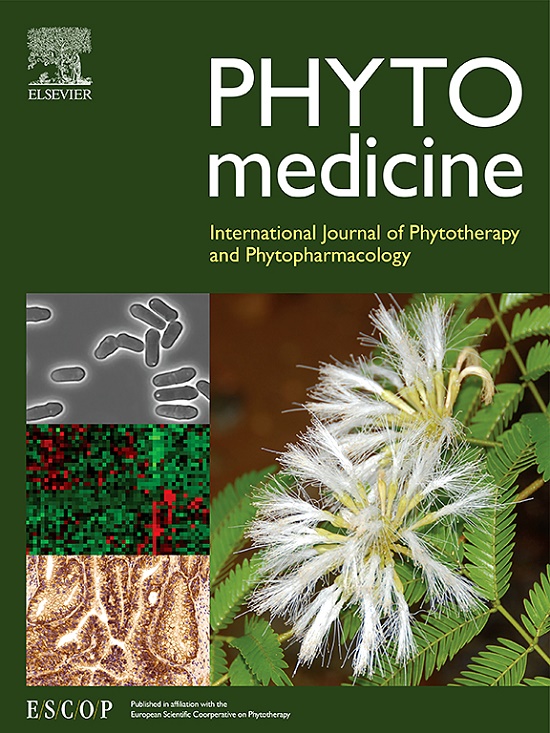Duhuo Jisheng Mixture attenuates neuropathic pain by inhibiting S1PR1/P2Y1R pathway after Chronic Constriction Injury in mice
IF 6.7
1区 医学
Q1 CHEMISTRY, MEDICINAL
引用次数: 0
Abstract
Background
The pathogenesis of neuropathic pain is complex and lacks effective clinical treatment strategies. Medical plants and herbal extracts from traditional Chinese medicine with multi-target comprehensive effects have attracted great attention from scientists.
Purpose
To investigate the pharmacological active components and mechanism underlying the anti-neuralgia effect of classic analgesic formulas Duhuo Jisheng Mixture (DJM).
Study design and methods
Chronic Constriction Injury (CCI) surgery was used to assess the efficiency of DJM in treating neuropathic pain. Forty-two C57BL/6 mice were evenly divided into seven groups: sham-operated, sham treatment with DJM (20 ml/kg), CCI treatment with DJM (0, 10, 20, or 40 ml/kg) and CCI treatment with Morphine (3 mg/kg). DJM irrigation stomach was implemented from post-operative day (POD) 0 to POD 21. Paw withdrawal threshold and Thermal latency were conducted on POD 0, 1, 3, 5, 7, 14 and 21. On POD 14, eEPSP in spinal dorsal horn neurons was recorded by patch-clamp. mRNA transcription in spinal cord was also monitored to screen molecular targets and signaling pathways on POD 14. To further validate the influence of DJM on the S1PR1 signaling pathway, 1 mg/kg W146 was infused into mice intrathecally and delivered to the cerebral spinal fluid through one 30 G needle with a whole 20 μl intervertebral between the L5 and L6. Furthermore, the active ingredients of DJM were identified through LC/MS equipment and predicted through Molecular Docking.
Results
We demonstrated that DJM treatment reversed CCI-induced pain sensitivity and the excitability of neurons, decreased up-regulation of astrocyte S1PR1, inhibited astrocyte activation, and further inhibited the expression of Purinergic P2Y1R and its downstream molecule p-JNK in mouse spinal cord, as well as the release of inflammatory factors. Interestingly, due to the regulatory role of astrocytes on neurons, the effects of DJM on astrocytes ultimately manifest in pain-effector neurons, resulting in decreased p-ERK, p-CREB, and pain-marking protein c-fos in neurons. S1PR1 Antagonist W146 possessed an equivalent analgesic effect as DJM and inhibited S1PR1 and c-fos expression. According to LC/MS analysis results, a total of 33 active ingredients were screened, of which 20 active ingredients had good binding activity with S1PR1 and were considered to be the main active ingredients for analgesia.
Conclusion
This study is the first to clarify the effect and molecular mechanism of DJM for anti-neuralgia in particular, which confirms the clinical value of DJM in relieving neuropathic pain. Furthermore, this study innovatively identifies the potential pharmacological components of DJM through LC/MS and Bioinformatics technology, which forms a framework for people's understanding of DJM treatment for neuropathic pain and provides a sufficient theoretical basis of DJM for clinical application.

求助全文
约1分钟内获得全文
求助全文
来源期刊

Phytomedicine
医学-药学
CiteScore
10.30
自引率
5.10%
发文量
670
审稿时长
91 days
期刊介绍:
Phytomedicine is a therapy-oriented journal that publishes innovative studies on the efficacy, safety, quality, and mechanisms of action of specified plant extracts, phytopharmaceuticals, and their isolated constituents. This includes clinical, pharmacological, pharmacokinetic, and toxicological studies of herbal medicinal products, preparations, and purified compounds with defined and consistent quality, ensuring reproducible pharmacological activity. Founded in 1994, Phytomedicine aims to focus and stimulate research in this field and establish internationally accepted scientific standards for pharmacological studies, proof of clinical efficacy, and safety of phytomedicines.
 求助内容:
求助内容: 应助结果提醒方式:
应助结果提醒方式:


